Banbi (Chinese : 半臂 ; lit.'half-arm'), [1] also known as banxiu (Chinese : 半袖 ; lit.'half-sleeves') [2] and sometimes referred as beizi (Chinese : 褙子 ) or half-beizi (i.e. short-sleeved beizi) before the term beizi eventually came to refer to a long-sleeved beizi in the Song dynasty, [3] and referred as dahu in the Yuan dynasty, [2] is an upper garment item in Hanfu . The banbi is in the form of a waistcoat or outerwear with short sleeves, which could either be worn over or under a long-sleeved ruqun . [1] The style of its collar varies; it can also be secured at the front either with ties or a metal button. [4]
Contents
- Classification
- History
- Ancient
- Tang dynasty
- Song dynasty
- Yuan dynasty
- Ming dynasty
- Qing dynasty
- Derivative and Influences
- China
- Japan
- Korea
- Similar-looking items
- See also
- References
Classification
There were various forms of banbi throughout history. In present days, the different forms of banbi are generally classified based on their collar shapes: e.g. duijin (Chinese :对襟) which is straight or parallel in shape; jiaoling (Chinese :交领) which is cross-collared in shape; tanling (Chinese :坦领) which is U-shaped, [5] [4] yuanling (Chinese :圆领) which is round-collared in shape; and fangling (Chinese :方领) which is squared-collared in shape.
History
Ancient
According to the Chinese records, the banbi was a clothing style, which was invented from the duanru (Chinese :短襦; lit.'short jacket') that the Chinese wear. [6] It was first designated as a waistcoat for palace maids, but its popularity soon reached the commoners. [6] It was recorded in the Book of Jin, when Emperor Ming of Wei met Yang Fu, the emperor himself was dressed in commoner's banbi. [6] [7]
- Han dynasty banbi
- A woman wearing a cross-collared banbi, Han dynasty.
- Woman wearing a cross-collared banbi, Eastern Han dynasty, 25–220 AD.
- Cao Wei, Jin, Northern and Southern dynasties
- A woman wearing a parallel collar banbi, Northern Wei dynasty, about 522 AD.
- Women wearing parallel collar banbi, Southern Dynasties Brick Relief.
Tang dynasty
During Tang dynasty, the banbi was worn by men and women. [8] The banbi was a staple clothing item for the Tang dynasty women, along with shan (a blouse which could be low cut during this period) and high-waisted skirts. [9] The banbi was worn on the shan. [8] [9] The banbi could either be worn under or over the skirt. [1] Banbi could also be worn under the yuanlingshan. [9]

During Tang dynasty, there was another form of banbi or short sleeve waistcoat worn called kedang (袔裆). The sleeve covers around the shoulder area and there is no opening in the front or back. In order to wear it, people would have to tuck in, then out from the neck of the clothing. Generally, it's worn outside of a long sleeve shirt. In the "Legend of Huo Xiao Yu" (崔小玉传) that was written during Tang dynasty, the main female character Huo Xiaoyu wear this style most of the time. [6] [11] It is suggested that a type of banbi was adopted from Central Asia during the Tang dynasty through the Silk Road when cultural exchanges were frequent, and that it was also known as beizi during Tang dynasty. [12] [13] In the early Tang dynasty, the shape of the banbi worn in this period appears to have been mainly influenced by those worn in Qiuci, for example, the shape of the U-shaped banbi in Qiuci shared similarities with those worn in the early Tang dynasty. [10]
In Japan's Nara city, the Todaiji temple's Shosoin repository has 30 banbi (called hanpi in Japan) from Tang dynasty China; they are cross-collared closing to the right, most dating from the 8th century. [14] : 105 The eighth century Shosoin banbi's variety show it was in vogue at the time and most likely derived from much more ancient clothing. [14] : 106
- Tang dynasty banbi
- Court Ladies of the Tang dressed in Banbi with scarfs wrapped around it.
- A painting of a lady during the Tang dynasty.
- A Tang dynasty Woman wearing a green, U-shaped collar banbi.
- Fresco of a Tang dynasty Musician wearing a loose, red cross-collared banbi.
- Fresco of a Tang dynasty Musician wearing a loose, blue cross-collared banbi.
- A Tang dynasty Woman wearing a red U-shaped collar banbi under her skirt.
- The bulges at the woman's shoulders areas hints the presence of a banbi worn under yuanlingshan.
- Baby banbi, Tang dynasty
Song dynasty
In the Song dynasty, the half-beizi (i.e. banbi) was originally a military uniform which was later worn by the commoners and by the literal class. [3]
Yuan dynasty
In the Yuan dynasty, the casual clothing for men mainly followed the dress code of the Han people and they wore banbi as a casual clothing item while ordinary women clothing consisted of banbi and ruqun. [15] Han Chinese women also wore a combination of a cross-collar upper garment which had elbow length sleeves (i.e. cross-collar banbi) over a long-sleeved blouse under a skirt with an abbreviated wrap skirts were also popular in Yuan; [16] : 19–20 [17] : 142 This form of set of clothing was a style which slightly deviated from the ruqun worn in the Tang and Song dynasties. [17] : 142
There were several types of banbi in the Yuan dynasty: straight collar short shan with half-sleeves (直领短衫), a half-sleeved long robe (changpao 长袍) with a cross-collar closing to the right (jiaoling youren 交领右衽) which was specifically called dahu (was worn by Mongol men during and prior to the founding of the Yuan dynasty [18] : 43, 52 [17] : 139–140 ), and square-collar long robe (方领对襟长袍) with half-sleeves. [19]
- Two women (right) wearing parallel collar banbi, Yuan dynasty
- Women wearing banbi over aoqun.
- Khutughtu Khan wearing a dahu, Yuan dynasty, ca. 1330–32. [20]
- Women depicted in the Fresco in the Hall of King Mingying. Han women wore elbow-length sleeves, cross-collar upper garment over a long-sleeved blouse; the abbreviated skirts were popular in Yuan. [21]
Ming dynasty
In the Ming dynasty, the dahu was either a new type of banbi whose designs was influenced by the Mongol Yuan dynasty clothing. [22] [23]
- A Ming dynasty portrait illustrating a woman wearing Banbi
- A Ming dynasty portrait illustrating a woman wearing Banbi
- A man wearing a green dahu , a Ming dynasty painting.
Qing dynasty
In the Qing dynasty dictionary called Gujin Tushu Jicheng《古今圖書集成》, the banbi is depicted with no sleeves.
- Banbi, from the Gujin Tushu Jicheng , section "Ceremonial Usages", between 1700 and 1725
Derivative and Influences
China
It is assumed that the long-sleeved beizi (褙子), which originated in the Song dynasty, [3] [24] was derived from the banbi, when the sleeves and the garment were lengthened. [25] [26] According to Ye Mende, the beizi was initially worn as a military clothing with "half-sleeves"; the sleeves were later extended and hanging ribbons were added from the armpits and back. [3]
Japan
Hanpi

In Japan, banbi are known as hanpi (半臂/はんぴ, lit. "half-arm") and are short coats. [14] : 105 [27] In Japan, the hanpi was either imported from China or were modelled to look very closely to the Tang dynasty banbi. [14] It was as a sleeveless short undergarment for men of the aristocracy; [28] it commonly worn in summer. [27]
Korea
During the rule of Queen Jindeok of Silla (r. 647–654), Kim Chunchu personally traveled to Tang to request for clothing and belts; one of the requested clothing was banbi (반비/半臂). [29] The banbi later reappeared in the clothing prohibition decreed by King Heungdeok of Silla (r. 826–836). [29] [8] During the Silla period, the banbi may have been worn on sam (衫, a type of upper garment) which also corresponds to the way banbi was worn by men and women during the Tang dynasty. [8]
The banbi from the Unified Silla period appears to have also been worn in Goryeo. [30] [31]
Similar-looking items
See also
Related Research Articles
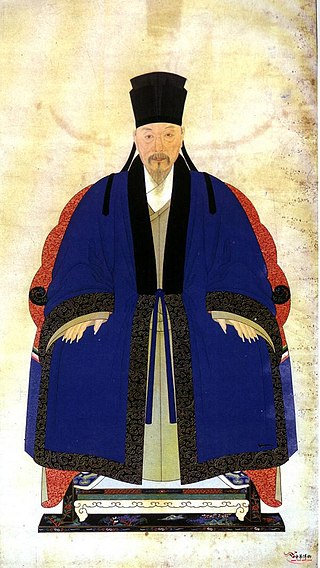
Beizi, also known as beizi and chuozi, is an item worn in traditional Chinese attire common to both men and women; it is typically a large loose outer coat with loose and long sleeves. It was most popular during the Song dynasty, Ming dynasty, and from the early Qing to the Mid-Qing dynasty. The beizi originated in the Song dynasty. In the Ming dynasty, the beizi was referred as pifeng. When worn by men, it is sometimes referred as changyi, hechang, or dachang when it features large sleeves and knotted ties at the front as a garment closure.
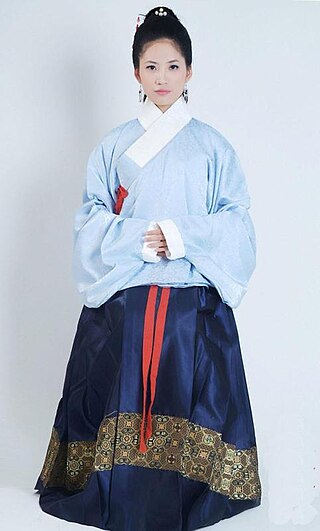
Ruqun is a set of attire in Hanfu which consists of a short jacket typically called ru worn under a long Chinese skirt called qun. However, when use as a general term, ruqun can broadly describe a set of attire which consists of a separated upper garment and a wrap-around lower skirt, or yichang, in which yi means the "upper garment" and the chang means the "lower garment". In a broad sense, ruqun can include the shanqun and aoqun in its definition.

Chang-ao, lit. translated as "long jacket" or "long ao", is a historical long-length, Chinese upper garment called ao (袄), which was worn by women. It is also known as da ao (大袄) and chang ru which appears to be the precursor of the ao.
A yuanlingshan is a type of round-collared upper garment in the traditional Chinese style of clothing known as Hanfu; it is also referred to as a yuanlingpao or a panlingpao when used as a robe. The yuanlingshan and yuanlingpao were both developed under the influence of ancient Chinese clothing, known as Hufu, originating from the Donghu people during the early Han dynasty and later by the Wuhu, including the Xianbei people, during the Six Dynasties period. The yuanlingpao is an article of formal attire primarily worn by men, although in certain dynasties, such as the Tang dynasty, it was also fashionable for women to wear. In the Tang dynasty, the yuanlingpao could be transformed into the fanlingpao using buttons.
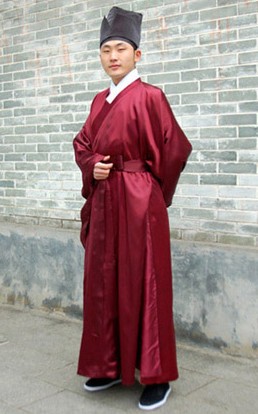
Daopao, also known as xuezi when used as a Xifu during Chinese opera performances, and deluo when it is blue in colour, is a traditional form of paofu in Hanfu and is also one of the most distinctive form of traditional clothing for the Han Chinese. The daopao was one of the most common traditional form of outer robe worn by men. Daopao literally means "Taoist robe"; however, despite its name, the daopao were and is worn by men, and did not imply that its wearer had some affiliation to taoism. The daopao can be dated back to at least the Ming dynasty but had actually been worn since the Song dynasty. Initially the daopao was a form of casual clothing which was worn by the middle or lower class in the Ming dynasty. In the middle and late Ming, it was one of the most common form of robes worn by men as casual clothing. The daopao was also a popular formal wear by the Ming dynasty scholars in their daily lives. It was also the daily clothing for the literati scholars in the Ming dynasty. In the late Ming, it was also a popular form of clothing among the external officials and eunuchs sometimes wore it. The daopao was also introduced in Korea during the Joseon period, where it became known as dopo and was eventually localized in its current form.
Panling lanshan (盤領襴衫), also referred as lanshan (襴衫), is a traditional Chinese attire for men. It is a specific form of round collar robe, known as yuanlingpao, which is characterized with the use of hem, called hanglan (横襕), also referred as lan (襕)). The panling lanshan was a new type of garment, developed in the Northern and Southern dynasties through the localization of the round-collar garments which had been introduced by the ethnic minorities, such as the Xianbei. Panling lanshan continued to be worn in the Tang dynasty. The panling lanshan along with the futou was used as the Tang dynasty attire of scholars and officials. The scholars' attire in the succeeding dynasties followed the style of the panling lanshan of the Tang dynasty. It is also a formal attire worn by scholars and students (生員) taking the imperial examination in Ming dynasty.

Daxiushan, also referred as dianchailiyi, dashan, daxiu, is a form of shan, a traditional Chinese upper garment, with broad sleeves in Hanfu. It was most popular during the Tang dynasty, particularly among the members of royalty. The daxiushan was mainly worn for special ceremonial occasions and had different variations, mainly the result of different collar formations. The daxiushan could be worn under a skirt or as an outerwear. After the Tang dynasty, it continued to be worn in the Song and Ming dynasties.

In China, women had different kinds of clothes in ancient times. Those clothes changed with the dynasty. For examples, in the 1920s, the Cheongsam was fashionable among socialites and upperclass women; during the 1960s, very austere clothing styles were prevalent; today, a wide variety of fashions are worn. Different provinces and regions of China also have different clothing styles.
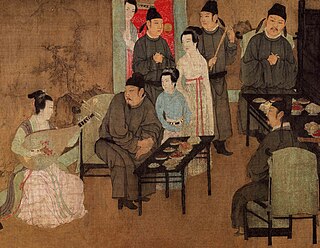
Hanfu, are the traditional styles of clothing worn by the Han Chinese since the 2nd millenium BCE. There are several representative styles of hanfu, such as the ruqun, the aoqun, the beizi and the shenyi, and the shanku.

Qixiong ruqun, which can also be referred as Qixiong shanqun, also known as "chest-high ruqun", is a set of attire in hanfu, the traditional Chinese clothing worn by the Han Chinese. The qixiong ruqun is a unique style of ruqun, which is characterized with a high waistline qun, Chinese skirt. The qun used in the qixiong ruqun is generally tied above the bust level. It was worn by women during the Southern dynasties, Sui dynasty, Tang dynasty and Five Dynasties and Ten Kingdoms period. The style was also revived in the early and middle Ming dynasty.
The fashion in the Yuan dynasty of Mongol (1271–1368) showed cultural diversity with the coexistence of various ethnic clothing, such as Mongol clothing, Han clothing and Korean clothing. The Mongol dress was the clothing of elite for both genders. Mongol attire worn in the 13th-14th century was different from the Han clothing from the Tang and Song dynasties. The Yuan dynasty court clothing also allowed the mixed of Mongol and Han style, and the official dress code of the Yuan dynasty also became a mixture of Han and Mongol clothing styles. After the founding of the Yuan dynasty, the Mongols strongly influenced the lifestyle and customs of the Han people.

Yesa robe, also known simply referred as Yesa, Yisan, or Yisa, is an ancient type of Chinese clothing worn during the Ming dynasty. It originated in the Ming dynasty but was influenced from clothing of the Yuan dynasty. It is sometimes described as being a sinicized version of the Mongol's jisün and could only be found in China. Yesa was a regular clothing in the Ming dynasty; it was initially worn in the palace and by the wealthy, and it later spread to the commoners.

Yunjian, also known as Cloud collar in English and sometimes referred as châr-qâb, is a Chinese term which can either to a four-lobed motif, or to a traditional Chinese garment accessory item in Hanfu, the Traditional clothing of the Han Chinese, which is typically found in the form of a detachable collar with cloud patterns and is worn over the shoulders area, similar to a shawl. As an garment accessory, the yunjian is also typically found in four-lobed design although multi-lobed design also existed throughout history. The yunjian could also be applied directly on garments, where it would fall around the collar of robes onto the chest and shoulder region,or as a clothing appliqué. In China, the yunjian has both ceremonial and practical uses when used in clothing. As a garment item, the yunjian was an important clothing element for Chinese women, especially in the Ming and Qing dynasties; its usage was spread across China where it became associated with the Han Chinese's wedding clothing. In Henan, brides would wear yunjian decorated with hanging ribbons and bells. It also had the practical use of preventing clothing from being dirty and oily by covering up the clothes and by covering up the stains. The yunjian is used in Peranakan wedding; the multi-layered yunjian worn by Chinese brides on the day of their wedding is sometimes known as "phoenix collar". The yunjian also started to be worn by the Non-Chinese, the Tartars of northern China and Manchuria in the later medieval period.
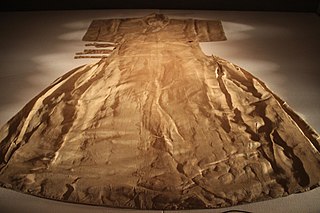
Dahu was a form of robe/jacket which originated in the Ming dynasty. In Ming dynasty, the dahu was either a new type of banbi or a sleeveless jacket, whose designs was influenced by the Mongol Yuan dynasty clothing.

Shanku is a generic term which refers to a two-piece set of attire in Hanfu, which is typically composed of a youren yi, a Chinese upper garment which typically overlaps and closes on the right side which could be called shan, ru, ao, and a pair of long trousers ku. As a form of daily attire, the shanku was mainly worn by people from lower social status in China, such as labourers, shopkeepers, or retainers from wealthy household. The shanku was originally worn by both genders. Up until the mid-20th century, it was popular in China and outside of China where it was worn by overseas Chinese in countries, such as Singapore, Malaysia, Suriname, etc. It is still worn in present-day China and can be found in rural areas.
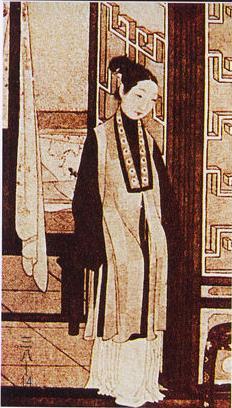
Bijia is a long, sleeveless jacket of Mongol origins which has opened side slits. The bijia started to be worn in the Yuan dynasty when it was designed by Empress Chabi. The bijia eventually became one of the most typical form of women's clothing item in the Ming dynasty and in the Qing dynasty. It is also a type of hanfu which has been revived in present days.

Hufu, also referred as Hu clothing, nomadic dress, 'barbarian' clothing or dress, or foreign dress, is a generic term which refers to any clothing which was worn in ancient China and its surrounding regions by non-Han Chinese people. This term is also used to refer to clothing of foreign origins in ancient China. The introduction of Hufu-style garments and attire in China occurred by the time of King Wuling of Zhao.

Ru, sometimes referred to as shan, ao, and yi, is a form of traditional Chinese upper garment, or coat, or jacket, which typically has a right closure; however, they may also have a front central opening. It is traditional everyday wear for women of the Han Chinese ethnic group. It can be worn in combination with a skirt in a style called ruqun, or a pair of trousers in a style called shanku.

Tanling ruqun, also known as Tan collar ruqun and U-collar ruqun, is a type of Hanfu which was developed under the influence of Hufu ; it is a form a kind of ruqun which typically consists of three parts, featuring a low-cut low-cut U-shaped collar upper inner garment with long sleeves, a U-shaped collar banbi upper outer garment with short sleeves, a long high-waisted skirt. It can also be adorned with a shawl, called pipo. It was a popular form of clothing attire in the Sui and Tang dynasty. In the 21st century, the Tanling ruqun re-appeared as a result of the Hanfu movement. The 21st century Tanling ruqun was developed by reproducing the original patterns of the historical tanling ruqun while being aligned with modern aesthetics.

Garment collars in hanfu are diverse and come in several shapes, including jiaoling, duijin, yuanling, liling, fangling, tanling. Some forms of collars were indigenous to China while others had been adopted from the Hufu of other non-Han Chinese ethnic minorities and/or from the clothing worn by foreigners.
References
- 1 2 3 Chen, BuYun (2017-01-02). "Material Girls: Silk and Self-Fashioning in Tang China (618–907)". Fashion Theory. 21 (1): 5–33. doi:10.1080/1362704X.2016.1138679. ISSN 1362-704X. S2CID 155949571.
- 1 2 张, 国伟 (2013). "元代半臂的形制与渊源".
半臂又做半袖,到元代也称搭护。
- 1 2 3 4 Zhu, Ruixi; 朱瑞熙 (2016). A social history of middle-period China : the Song, Liao, Western Xia and Jin dynasties. Bangwei Zhang, Fusheng Liu, Chongbang Cai, Zengyu Wang, Peter Ditmanson, Bang Qian Zhu (Updated ed.). Cambridge, United Kingdom: Cambridge University Press. pp. 17–18. ISBN 978-1-107-16786-5. OCLC 953576345.
- 1 2 "Hanfu Making(7) - Banbi Cutting & Sewing Patterns - 2021". www.newhanfu.com. 4 August 2021. Retrieved 2021-12-20.
- ↑ "About Ruqun, You Should Know These - 2021". www.newhanfu.com. 2019. Archived from the original on 2021-05-15. Retrieved 2021-12-20.
- 1 2 3 4 Wang Qiao-ling (2008). "Women Fashion of Tang Dynasty and Foreign Cultural Communication". 21. Journal of Zhejiang Wanli University: 1–3.
{{cite journal}}: Cite journal requires|journal=(help) - ↑ 《晋书·五 行志》云:"魏明帝著绣帽,披缭纵半袖,以见直臣。"
- 1 2 3 4 李, 鳳淑 (1983). "답호에 關한 硏究" [(A) study of Dapho]. 이화여자대학교 대학원.
- 1 2 3 Chen, Bu Yun (2013). Dressing for the Times: Fashion in Tang Dynasty China (618-907) (Thesis). Columbia University. doi:10.7916/d8kk9b6d.
- 1 2 Zhao, Qiwang; Lyu, Qianyun (2020). "Western Cultural Factors in Robes of Wei, Jin, Southern and Northern Dynasties as Well as Sui and Tang Dynasties" (PDF). 2020 3rd International Conference on Arts, Linguistics, Literature and Humanities: 141–147. doi:10.25236/icallh.2020.025 (inactive 31 January 2024).
{{cite journal}}: CS1 maint: DOI inactive as of January 2024 (link) - ↑ Information on Civilian Clothings 不拘一格说便服 [ permanent dead link ] oldbeijing.org Retrieved 2010-02-10
- ↑ Yoon, Ji-Won (2006). "Research of the Foreign Dancing Costumes: From Han to Sui-Tang Dynasty". 56. The Korean Society of Costume: 57–72.
{{cite journal}}: Cite journal requires|journal=(help) - ↑ Kim, Sohyun. A Study on the Costume of Khotan, The Korean Society of Costume, v. 34, 169-183. 1997.[ verification needed ]
- 1 2 3 4 Dusenbury, Mary M.; Bier, Carol (2004). Helen Foresman Spencer Museum of Art (ed.). Flowers, Dragons & Pine Trees: Asian Textiles in the Spencer Museum of Art (illustrated ed.). Hudson Hills. ISBN 1555952380.
- ↑ "Costume in the Yuan Dynasty---ASEAN---China Center". www.asean-china-center.org. Retrieved 2021-07-18.
- ↑ Sun, Ming-ju (2002). Chinese fashions. Mineola, N.Y.: Dover Publications. ISBN 0-486-42053-1. OCLC 55693573.
- 1 2 3 5000 years of Chinese costumes. Xun Zhou, Chunming Gao, 周汛, Shanghai Shi xi qu xue xiao. Zhongguo fu zhuang shi yan jiu zu. San Francisco, CA: China Books & Periodicals. 1987. ISBN 0-8351-1822-3. OCLC 19814728.
{{cite book}}: CS1 maint: others (link) - ↑ Shea, Eiren L. (2020). Mongol court dress, identity formation, and global exchange. New York, NY. ISBN 978-0-429-34065-9. OCLC 1139920835.
{{cite book}}: CS1 maint: location missing publisher (link) - ↑ 张, 国伟 (2013). "元代半臂的形制与渊源".
提出元代半臂的三种形制,即:直领短衫式半臂、交领右衽长袍式半臂(也称搭护)、方领对襟长袍式半臂。
- ↑ "Vajrabhairava mandala ca. 1330–32". www.metmuseum.org. Retrieved 2021-07-18.
- ↑ Sun, Ming-ju (2002). Chinese fashions. Mineola, N.Y.: Dover Publications. p. 19. ISBN 0-486-42053-1. OCLC 55693573.
- ↑ Wei, Luo (2018-01-02). "A Preliminary Study of Mongol Costumes in the Ming Dynasty". Social Sciences in China. 39 (1): 165–185. doi:10.1080/02529203.2018.1414417. ISSN 0252-9203. S2CID 149138176.
- ↑ "What is Da Hu - Chinese Traditional Male Clothing - 2021". www.newhanfu.com. 16 April 2021. Retrieved 2021-05-24.
- ↑ B. Bonds, Alexandra (2008). Beijing Opera Costumes: The Visual Communication of Character and Culture. University of Hawaii Press. p. 53. ISBN 9780824829568.
- ↑ 朱和平 (July 2001). 《中国服饰史稿》 (PDF) (in Chinese) (1st ed.). 中州古籍出版社. pp. 223–224. Retrieved May 20, 2009.
- ↑ Hua, Mei (2011). Chinese Clothing. Cambridge University Press. p. 36. ISBN 9780521186896.
- 1 2 Verschuer, Charlotte von (2008-01-01). "Le costume de Heian". Cipango. Cahiers d'études japonaises (in French) (Hors-série): 227–270. doi: 10.4000/cipango.1029 . ISSN 1164-5857.
- ↑ Japanese Architecture and Art Net Users System (2001). "Hanpi 半臂". www.aisf.or.jp. Retrieved 2022-03-19.
- 1 2 Ju-Ri, Yu; Jeong-Mee, Kim (2006). "A Study on Costume Culture Interchange Resulting from Political Factors". Journal of the Korean Society of Clothing and Textiles. 30 (3): 458–469. ISSN 1225-1151.
- ↑ Choi, Jeong (2015). "A Study on Historical Research for Costume of Banya(般若) in King Gongmin's Period of Late Goryeo - Focused on the Buddhist Service Costume -". Journal of the Korean Society of Costume. 65 (6): 112–132. doi: 10.7233/jksc.2015.65.6.112 . ISSN 1229-6880.
- ↑ 이, 은형 (2009). "네이버 학술정보" [Historical analysis and modernization work of Korean traditional Baeja]. academic.naver.com (in Korean). Retrieved 2021-05-14.
| Banbi | |
|---|---|
 Woman wearing a duijin banbi. |
| Characteristics |
| ||||||||||||||||||
|---|---|---|---|---|---|---|---|---|---|---|---|---|---|---|---|---|---|---|---|
| Garments |
| ||||||||||||||||||
| Headwear (list) | |||||||||||||||||||
| Footwear (list) | |||||||||||||||||||
| Accessories (list) |
| ||||||||||||||||||
| Influenced clothing | |||||||||||||||||||
| Cosmetics | |||||||||||||||||||


















